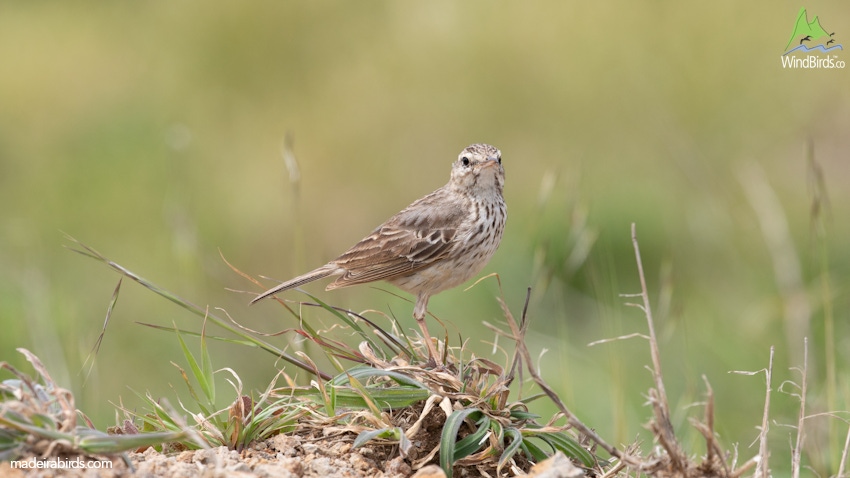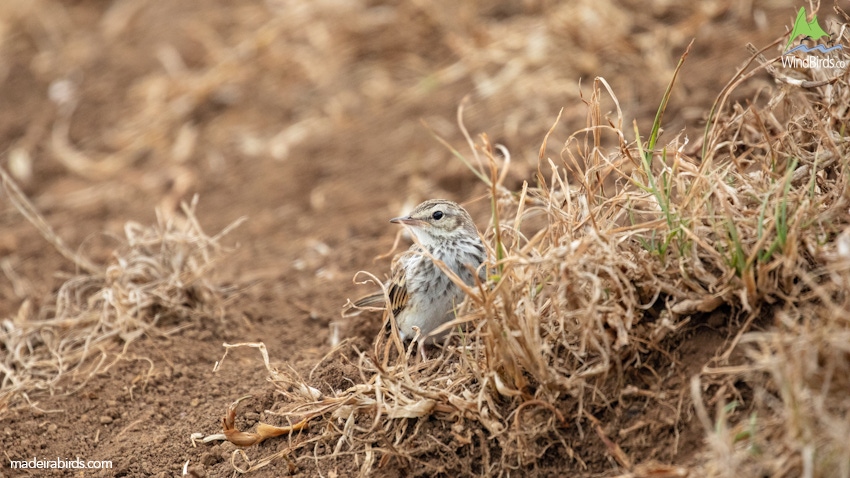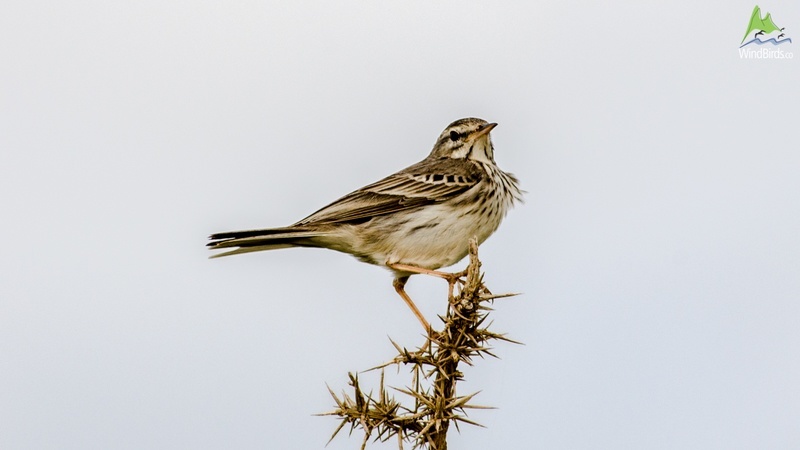Berthelot’s Pipit Anthus berthelotii Bolle, 1862
Order: Passeriformes Family: Motacillidae Status: Breeding in Madeira
Sub-species: Anthus berthelotii berthelotii Bolle, 1862
Sub-species: Anthus berthelotii maderensis (Erlanger 1899)
The subspecies Anthus berthelotii maderensis is given for Madeira, Porto Santo and Desertas Islands while Anthus berthelotii berthelotii is from Selvagens and Canary Islands. The main distinctive feature from both subspecies is the longer bill and middle toe on Madeira birds.
Recommended birdwatching tours to watch this bird
Half-day birdwatching
Full-day birdwatching

Berthelot's Pipit Field ID Keys
Shape & Size
A small pipit looking almost in an upright position with legs very pushed to the back of the body and quite a long bill for a pipit.
Colour Pattern
A dull brown-grey bird with some streaked upper-parts mostly visible in juvenile birds; a conspicuous white supercilium line and with fine light brown stripes on off-white underparts. It has pinkish legs.

Behavior
Walks and runs actively, rarely perching on trees though likes to perch on elevated rocks. Does not form large flocks being seen often alone. Usually calls along with its undulating flight or from the ground.
Habitat
Berthelot’s pipit is an endemic species of Madeira and Canary Islands associated with dry areas, sparsely covered with vegetation, some next to the sea, others in high altitudes.
Distinction from similar species
Berthelot’s pipit is the only pipit species resident in Madeira though there are records of Meadow pipit, Tree pipit and Tawny Pipit. The easiest way to distinguish them is by their calls, though these three species are bigger with yellowish underparts while the Berthelot’s have only whitish underparts with brownish streaks and no yellow on it.
Anthus berthelotii Biometrics
Total length: 13 - 14.5 cm (Svensson et al, 2009)
Other Bird Facts
Seasonality in Madeira: All year
Breeding: Nest is built in ground depressions covered with little vegetation, with 3 to 5 eggs laid on one or two annual broods.
Diet: Feeds on insects from the ground
Curiosities
In Madeira, people in rural areas used to call it “Our Lady’s bird”, giving rise to the legend that the Berthelot’s pipit accompanied the Holy Family in their journey from the Holy Land to Egypt, with the mission of wiping out with its long tail their footprints in the sand to avoid being followed by King Herod.
Status
Madeira local status by Correia-Fagundes et al, 2021:
Anthus berthelotii berthelotii - Common breeding bird
Anthus berthelotii madereinsis - Common breeding bird
Madeira local status by Romano et al, 2010:
Anthus berthelotii berthelotii - Common breeding bird
Anthus berthelotii madereinsis - Common breeding bird
Madeira local status by Zino et al, 1995:
Anthus berthelotii berthelotii - Common breeding bird
Anthus berthelotii madereinsis - Very Common breeding bird
Conservation status by the IUCN Red List Categories, 2013: Least Concern ver 3.1
Name of this species in other languages
Portuguese: Corre-caminhos
German: Kanarenpieper
Dutch: Berthelots Pieper
Swedish: Kanariepiplärka
Danish: Kanarisk Piber
Finish: Kanariankirvinen
Norwegian: Kanaripiplerke
Spanish: Bisbita Caminero
French: Pipit de Berthelot
Italian: Calandro di Berthelot
Polish: Swiergotek Kanaryjski
Slovak: ľabtuška ostrovná
Czech: Linduška kanárská
English synonyms: Canary Islands Pipit
